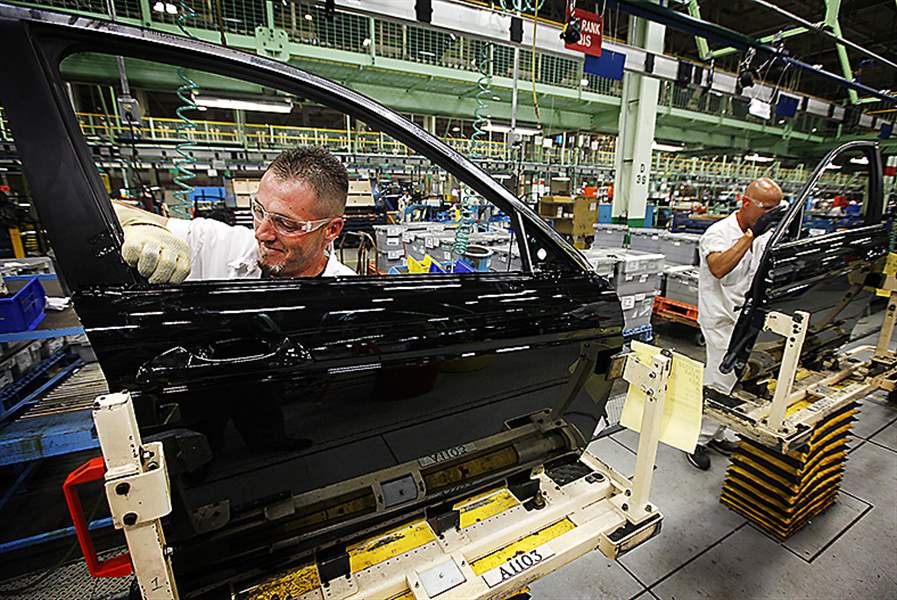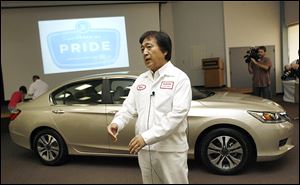
Honda’s U.S. exports exceed imports in ’13
Japanese automakers’ economic impact grows
1/28/2014
Honda builds the Accord, Crosstour, CR-V, Acura TL, and Acura RDX in two central Ohio plants. It began building the Accord in Marysille, Ohio, in 1982.
COLUMBUS DISPATCH

Honda builds the Accord, Crosstour, CR-V, Acura TL, and Acura RDX in two central Ohio plants. It began building the Accord in Marysille, Ohio, in 1982.
Honda Motor Co. built a record 1.3 million vehicles in the United States last year, and for the first time shipped more vehicles out of the country than it imported from elsewhere.
More than half of Honda’s U.S. production — 734,772 vehicles — comes from the company’s two central Ohio plants. Honda said it exported nearly 70,000 Ohio-made vehicles in 2013, a 69 percent increase over 2012.
The company builds the Honda Accord, Honda Crosstour, Honda CR-V, Acura TL, and Acura RDX in Ohio.
For Honda, becoming a net-exporter is a significant achievement. It is the first Japanese automaker to reach the milestone. It also shows just how far Honda has come since building its first Accord in the United States in 1982.
“In just a few decades, the expansion of free trade and growth in U.S. operations has transformed Honda from importing 100 percent of the cars sold in the U.S. to establishing the U.S. as an export and production hub,” Rick Schostek, senior vice president of Honda North America, said in a statement.
Honda exported a total of 108,705 U.S.-made vehicles last year, while it imported 88,537. The company says 95 percent of the vehicles it sells in the United States are produced in North America.
Still, experts say it’s unlikely that Honda will be viewed as being as “American” as Chrysler any time soon.
“If you ask the average American, they would say Chrysler is more of an American brand than Honda all day long,” said Clay Voorhees, an assistant professor of marketing at Michigan State University who studies automotive marketing.
The problem in that? Chrysler Group LLC, a Detroit fixture for generations, is now completely owned by Italy’s Fiat SpA.
That highlights one of the curiosities of today’s increasingly global automotive market. Not everything is as it seems, but consumers frequently go off history rather than present day facts.

Honda Motor Co. was Ohio’s largest automotive employer and 16th-largest company overall in 2012, with 13,500 employees. The company is led by Hide Iwata, shown here in Marysville in 2012.
Jaguar, a quintessentially British brand, is now owned by India’s Tata Group. Volvo has Chinese owners.
“I think it’s really the perception of where it comes from more than anything,” Mr. Voorhees said.
Branding aside, Honda and other Japanese automakers have had a big — and growing — impact on the U.S. economy as a whole.
Thomas Prusa, a professor of economics at Rutgers University, estimates that U.S. production of Japanese brands supported 700,000 U.S. jobs in 2012.
According to the Ohio Department of Development, Honda was the state’s largest automotive employer and 16th-largest company overall in 2012, with 13,500 employees. General Motors Co. was second among automakers, with 10,000 employees.
Mr. Prusa, who has written several papers on the topic, estimates another 680,000 U.S. jobs are supported by the dealer networks of the Japanese automakers. He said the income created from those nearly 1.4 million jobs was $85 billion in 2012.
“It turns out to be the Japanese are an important source of jobs, not actually a challenge,” he said.
While the Detroit Three account for nearly 50 percent of all U.S. auto production, Japanese companies now make up more than 40 percent.
“The Japanese are approaching the impact of the traditional Big Three automakers,” Mr. Prusa said. “That’s an impressive thing.”
Within a couple of years, he expects Toyota will also export more cars from the United States than it imports into the country.
There are several reasons for that. There has been an ongoing trend for automakers to build cars closer to their ultimate destination, and building in the country in which the cars will be sold removes some of volatility associated with exchange rates. There’s some marketing and politics behind it too.
In addition to its Ohio operations, Honda has plants in Alabama and Indiana. The company also builds vehicles in Canada and Mexico. The company will begin production of the new 2015 Honda Fit at a new plant in Mexico next month. That will bring Honda's total North American capacity to 1.9 million vehicles a year.
Contact Tyrel Linkhorn at:
tlinkhorn@theblade.com
or 419-724-6134.